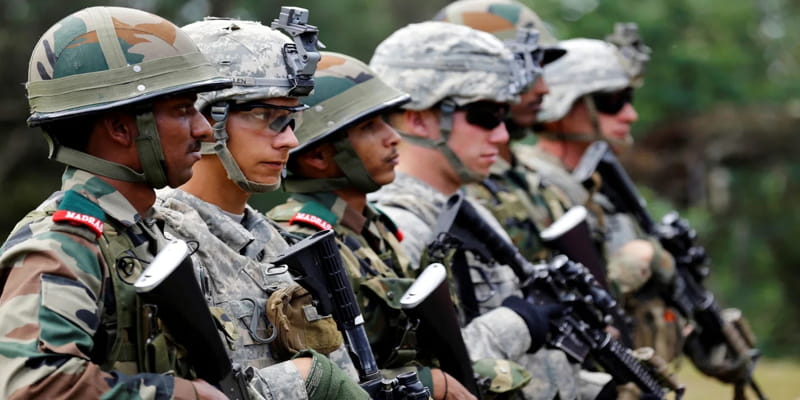
Defence – A robust pillar of India-US partnership

In the present-day geopolitical environment of big power competition, India and the US share convergence in perceptions over the challenge being faced in maintaining a free, open, and inclusive Indo-Pacific. There is a realisation of the mutual need for this partnership and of the relevance of India’s military power in meeting emerging challenges in South Asia and the Indian Ocean.
Within this multifaceted `Comprehensive Global Strategic Partnership,’ cooperation in the field of defence and security has become the central pillar of the relationship and an island of continuity.
Some observers find it "breathtaking in its intensity and scope."
This analysis briefly covers the current state of India-US defence relations, differences in perception and suggestions for continued strengthening of this partnership.
Impressive progress
Over the last two decades, the defence partnership between India and the US has grown rapidly. India was designated as a Major Defence Partner (MDP) of the US in 2016 (NDAA 2017). The two countries have finally concluded “foundational agreements” - the Logistic Exchange Memorandum of Agreement (LEMOA) signed in August 2016; the Communications Compatibility and Security Agreement (COMCASA) signed in September 2018; and the Basic Exchange and Cooperation Agreement (BECA) for geo-spatial cooperation, signed in October 2020. India and the US have also signed the Industrial Security Annexe (ISA) to the General Security of Military Information Agreement (GSOMIA-2002) in December 2019, enabling the private sector industry to share classified information and technology. In July 2018 the US placed India in the Strategic Trade Authorisation (STA–1) category, enabling access to advanced defence technologies and allowing controlled items to be exported under defined conditions without a transaction-specific license. This was done despite India not yet being a member of the Nuclear Suppliers Group (NSG) owing to politically motivated opposition from China.
During the period 2014-2015, a flagship defence cooperation programme, the Defence Trade and Technology Initiative (DTTI), was formally initiated.It is aimed at increasing the flow of technology and investments; creating capabilities and partnerships for co-development and co-production; and enhancing cooperation in research and development. Despite substantial criticism, DTTI has been a “silent enabler,” which has contributed substantially towards achieving the milestones listed above. Its success has helped elevate the relationship to the pedestal where India-US `Initiative on Critical and Emerging Technology (iCET) could be initiated and operationalised in January 2023.
India and the US cooperate extensively under the Military Education and Training Programme. India also conducts the largest number of bilateral and multilateral joint military exercises with the US as compraed to any other country. These include Yudh Abhyas – an army battalion level exercise, being held since 2002; Vajra Prahar – a special forces exercise being conducted since 2010; Tarkash – an exercise with the Indian National Security Guard since 2015; Malabar – a premier naval operational exercise being conducted bilaterally since 1992 (except a brief disruption in 1998); and Cope India – a bilateral air force exercise instituted in 2004. A bilateral tri-service amphibious military exercise Tiger Triumph has been introduced since November 2019. India also participates periodically in the Red Flag Air Force exercise and the Naval biennial Rim-of-the Pacific (RIMPAC) exercise conducted by the USINDOPACOM. It would interest to note that six of these exercises have been held during the eight months from August 2022 to April 2023.
In the area of defence trade and industry cooperation, the US is the third-largest arms supplier to India, providing approximately 11% of its weapon imports. Since 2008, the two countries have concluded more than $20 billion in defence trade, including procurement of C-130J (12), C-17 transport aircraft (11), P-8I maritime patrol aircraft (12), Harpoon missiles, Apache (28), Chinook (15), MH-60R (24) helicopters, and M777 Ultralightweight Howitzers (145). India is also procuring F404 – GE IN 20 engines for its Light Combat Aircraft (LCA) and has selected GE – F 414 INS 6 for the Mark II version. Deliberations are underway to explore the setting up of its production facilities in India.
Robust cooperation programmes also exist in the field of defence technology and innovation between the Defence Research and Development Organisation (DRDO) and the US Department of Defence (DoD). A Memorandum of Intent exists between the US Defence Innovation Unit (DIU) and Indian Defence Innovation Organisation – Innovation for Defence Excellence (DIO- iDEX), to identify avenues of cooperation. Cooperation also exists in domains of cyber and space situational awareness. The challenge, now lies in implementation and strategic leveraging by both sides.
Differences in perception
There are two key divergences in our overall national outlook. One, while India seeks an equitable, exclusive, and multipolar world order, the US policy is based on the premise of US primacy. Two, inadequate distinction is made between expectations from and responsibilities towards `allies' and `partners.' India, with its unique strategic character, is a reliable partner, not an ally.
In recent times there have been differences over India's approach to the war in Ukraine. One of the ardent India watchers in the US recently wrote, “India’s response is shaped NOT by abstract concerns about the integrity of the world order, but by purposeful Indian calculations about how alienating Russia might undermine its security.” It is, however, creditable that in the interest of long-term convergence, this has not become an issue between us.
There are certain perceptional variations, specific to the field of defence and security:
(a) Overall nuances of transacting defence relationship.
At a macro level, there is a narrative that our defence and security relations have become a skewed or an "overburdened pillar' of the relationship.
It is being opined that the bilateral relationship should be made broader based to include trade, economy, energy, environment, cyber, digital issues etc. The pragmatism of executing this, however, is not adequately appreciated.
(b) Differences in the priorities accorded to geographic areas of responsibility in the Indo-Pacific. The focus of the US and its allies in East and Southeast Asia, while India's emphasis is on Indian Ocean security, in particular the Western Indian Ocean.
(c) Priority of maritime domain for developing operational capability. The US perception is of India according priority to the maritime domain, to exploit its vantage geographic location to meet the China challenge in the Indian Ocean. It considers land-centric capability development as a `territorial fix' and India's `strategic trap.’ India however believes that it must accord balanced priority to both, the continental as well as maritime domains, with an edge towards the former, because of the existential threat of securing our borders. The maritime domain will incrementally gain salience with India's GDP growth.
(d) On developing interoperability. There is a prevailing perception within the United States that interoperability is primarily dependent on the commonality of platforms and equipment. On the Indian side, where we have a large inventory of different origin platforms and weapon systems, we believe that interoperability can be achieved by streamlining command, control and coordination structures, communication procedures, drills etc.
There is a contradiction between the Indian imperative and the US apprehension of India – Russia relations. 60-65% of India’s military holdings consist of Russian-origin equipment. It is known that this legacy relationship was developed with the Soviet Union/ Russia, when the US was not able to partner with India- a point highlighted by Secretary of State Anthony Blinken in his Congressional hearing in April 2022.
Mutual apprehension also exists about technology security and Indian apprehensions of the vulnerability of command-and-control systems. India- Russia relationship. There is a contradiction between the Indian imperative and the US apprehension of India – Russia relations. 60-65% of India’s military holdings consist of Russian-origin equipment. It is known that this legacy relationship was developed with the Soviet Union/ Russia, when the US was not able to partner with India- a point highlighted by Secretary of State Anthony Blinken in his Congressional hearing in April 2022. Mutual apprehension also exists about technology security and Indian apprehensions of the vulnerability of command-and-control systems.
(f) Defence trade & technology cooperation. There is a mismatch of priorities with US primacy being on trade and India’s on technology acquisition. Some within the US defence industry also expect receiving non-competitive access to the Indian defence markets and express frustration over the long-drawn acquisition process with uncertain budgets. Also, India’s efforts at indigenisation are perceived to be protectionism. These concerns merit reconciliation.
Looking ahead
The following aspects merit consideration for the continued strengthening of this relationship:
(a) Strong defence, security and critical technology partnerships can only be built on strategic underpinnings, founded on a pragmatic understanding of respective fundamental foreign policy imperatives and national interests.
(b) In a larger context, the endeavour should be on maintaining defence, security and critical technology as the "spinal cord" of our bilateral relationship. These should be kept insulated from the numerous other contentious issues, to the extent possible.
(c) In meeting the China challenge, it is more important to see an India with strong armed forces, than be overly concerned about the source from which it acquires its weapons.
(d) India–US and India- Russia relations are not a cold war era zero-sum relationship. There is need to remain mindful of legacy partnerships and the progressively changing contours. As aptly stated by US Secretary of Defence Lloyd Austin, "It would be prudent on the part of the US to let Indian Armed forces get used to operational benefits and ease of use of US origin systems – till these become acquisitions of choice; rather than being forced by US pressure. That would be counterproductive.
(e) Need for better comprehension of the evolutionary process and timelines of defence industrial cooperation and the nuances of technology sharing (acquisition and absorption).
Conclusion
No defence and security relationship can be altruistic or exclusive. The pattern of cooperation must be aligned with respective global and internal policies and national interests. Mutual understanding and trust are fundamental in this domain. While India and the US have traveled a long way, the relationship still needs constant nurturing.
(Exclusive to NatStrat)